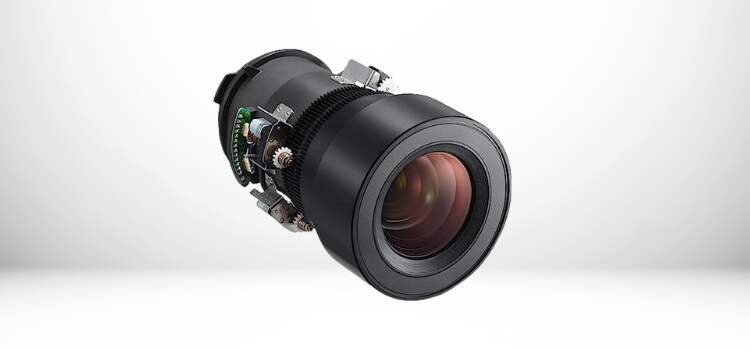As an Amazon Associate I earn from qualifying purchases.

Projectors have become a staple in many settings, from classrooms and offices to home theaters and conference rooms. These devices rely on a combination of intricate components to produce high-quality images on a projection surface. Projector lenses are crucial in determining these components’ clarity, focus, and overall image quality. In this article, we will delve into the workings of projector lenses, exploring their types, optics, and various aspects that affect their performance.
Understanding Projector Lenses

Projector lenses are optical devices designed to project light from the projector’s light source onto a projection surface. They are responsible for shaping and focusing the morning, allowing the formation of a clear and well-defined image. A projector lens comprises several elements arranged in a specific configuration to control factors such as focal length, aperture, and image distortion.
Types of Projector Lenses

Prime Lenses
The focal length of prime lenses, commonly referred to as fixed focal length lenses, is set and cannot be changed. They offer a single focal length, determining the distance between the projector and the projection surface needed to achieve a specific image size. Prime lenses are often used in applications requiring a particular throw distance and image size.
Zoom Lenses
On the other hand, Zoom lenses provide the flexibility to adjust the focal length, allowing for variable image sizes without changing the distance between the projector and the screen. These lenses feature a zoom mechanism that enables users to enlarge or reduce the image by changing the focal length. Zoom lenses are commonly used in environments where the projector needs to be versatile and adaptable to different projection setups.
Lens Elements and Optics
Focal Length
A projector lens’s focal length determines the image’s size. A shorter focal length produces a larger image, while a longer one produces a smaller one. It is essential to consider the throw distance and the desired screen size when choosing a projector lens with the appropriate focal length.
Aperture
The aperture of a projector lens controls the amount of light that passes through it. A wider gap allows more light to reach the projection surface, resulting in a brighter image. On the other hand, a narrower aperture restricts the amount of light, leading to a darker image. Adjusting the aperture is essential to achieving the desired brightness and contrast for the projected content.
Lens Coatings
Lens coatings are applied to projector lenses to minimize reflections and improve light transmission. These coatings reduce glare, ghosting, and other optical aberrations, improving image quality. Anti-reflective coatings, for example, help reduce the light reflected to the source, enhancing contrast and color accuracy.
Projection Throw and Image Size
The projection throw refers to the distance between the projector and the projection surface. It determines the size of the image displayed. Short-throw projectors are designed to produce larger images from shorter distances, making them suitable for small spaces. On the other hand, long-throw projectors can project larger images over greater distances.
Lens Shift and Keystone Correction
Lens shift is a feature available in some projectors that allow users to adjust the position of the projected image without physically moving the projector. It provides flexibility in projector placement, enabling users to align the image accurately on the screen.
Keystone correction is another essential feature compensating for image distortion caused by the projection angle. It digitally adjusts the shape of the projected image to make it appear rectangular, even if the projector is placed at an angle.
Lens Quality and Image Clarity
The projector lens’s quality directly impacts the projected image’s clarity and sharpness. High-quality lenses are designed to minimize distortions, aberrations, and color fringing, resulting in superior image quality with accurate colors and sharp details. Investing in a projector with a high-quality lens is essential for achieving the best possible image reproduction.
Maintenance and Cleaning
Regular maintenance and cleaning of projector lenses are crucial for optimal performance. Dust, fingerprints, and other contaminants can accumulate on the lens surface, degrading the image quality. Use a soft, lint-free cloth and a non-abrasive lens cleaning solution to clean the lens clockwise to remove dust or smudges. I followed the manufacturer’s directions while cleaning lenses, which is essential. I avoided using abrasive or robust solutions that might damage the lens coatings.
Choosing the Right Projector Lens
When selecting a projector lens, it is essential to consider the specific requirements of your projection setup. Factors such as throw distance, image size, room size, and lighting conditions should be considered. Consult the projector manufacturer’s specifications and seek expert advice to ensure the chosen lens is compatible with your projector model and meets your specific needs.
Frequently Asked Questions (FAQs)
Suppose you notice decreased image clarity, blurry spots, or streaks on the projected image. In that case, it may indicate that the lens requires cleaning. Regularly inspecting the lens for dust or fingerprints and cleaning it when necessary will help maintain optimal image quality.
Projectors are usually designed to work with specific lenses or lens systems. It is advisable to consult the projector’s manufacturer or refer to the user manual to determine if your projector is compatible with interchangeable lenses.
Fixed focal length or prime lenses have a single focal length and cannot be adjusted. Variable focal length lenses, or zoom lenses, offer flexibility as they allow you to adjust the focal length, enabling varying image sizes without changing the projector’s position.
To enhance the image quality of your projector, ensure that the lens is clean and free from dust or smudges. Adjust the projector’s focus, brightness, and contrast settings to optimize the image according to the viewing environment. Additionally, using a high-quality projector screen and controlling ambient lighting conditions can significantly improve the overall image clarity.
Projector lenses are typically designed for specific projector models and may not be interchangeable between different models. It is recommended to consult the projector manufacturer’s specifications or seek professional advice when considering interchangeable lenses.
Conclusion
Projector lenses are vital components that determine the quality and performance of a projector. Understanding their mechanics, types, and optical properties is essential for selecting the right lens and achieving optimal image projection. Whether you require fixed focal length lenses for precise installations or zoom lenses for flexibility, choosing high-quality lenses and properly maintaining them will ensure an immersive and visually captivating viewing experience.
Amazon and the Amazon logo are trademarks of Amazon.com, Inc, or its affiliates.
Leave a Reply